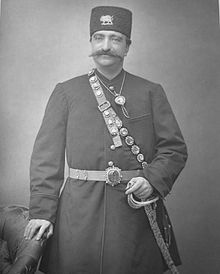Naser al-Din Shah Qajar
| Naser al-Din Shah Qajar ناصرالدین شاه قاجار |
|||||
|---|---|---|---|---|---|
Shahanshah of Persia |
|||||
 |
|||||
| Shah of Iran | |||||
| Reign | 5 September 1848 – 1 May 1896 | ||||
| Predecessor | Mohammad Shah Qajar | ||||
| Successor | Mozaffar ad-Din Shah Qajar | ||||
| Born |
16 July 1831 Tabriz, Persia |
||||
| Died | 1 May 1896 (aged 64) Tehran, Persia |
||||
| Burial | 2 May 1896 Shah-Abdol-Azim shrine |
||||
|
|||||
| Dynasty | Qajar dynasty | ||||
| Father | Mohammad Shah Qajar | ||||
| Mother | Malek Jahan Khanom, Mahd-e Olia | ||||
| Religion | Shia Islam | ||||
| Tughra |  |
||||
| Full name | |
|---|---|
| Nasser al-Din Shah |
Naser al-Din Shah Qajar (16 July 1831 – 1 May 1896) (Persian: ناصرالدین شاه قاجار), also Nassereddin Shah Qajar, was the King of Persia from 5 September 1848 to 1 May 1896 when he was assassinated. He was the son of Mohammad Shah Qajar and Malek Jahān Khānom and the third longest reigning monarch in Iranian history after Shapur II of the Sassanid dynasty and Tahmasp I of the Safavid Dynasty. Nasser al-Din Shah had sovereign power for close to 50 years and was also the first modern Iranian monarch to formally visit Europe.
The state under Naser Al-Din was the recognized government of Iran but its authority was undermined by local tribal leaders. The religious and tribal chieftains held quite a bit of autonomy over their communities. Naser Al-Din was not effective in implementing his sovereignty over his people. Local groups had their own militias and oftentimes did not obey laws passed by the monarchy since they did not have the power to enforce them. The people followed the ulama's fatwas instead of state issued law. When Naser Al-Din took power, his army barely had 3,000 men which was significantly smaller than the armies under various tribal leaders. When the state needed a proper army, he would hire the local militias. Prior to his reforms, Naser's government had very little power over their subjects and even during the reforms, they faced more scrutiny over their ability to implement those reforms successfully.
Naser al-Din was in Tabriz from Qajars tribe when he heard of his father's death in 1848, and he ascended to the Sun Throne with the help of Amir Kabir.
Naser al-Din had early reformist tendencies, but was dictatorial in his style of government. With his sanction, some Babis were killed after an attempt on his life. This treatment continued under his prime minister Amir Kabir, who even ordered the execution of the Báb – regarded as a manifestation of God to Bábí's and Bahá'ís, and to historians as the founder of the Bábí religion.
...
Wikipedia
